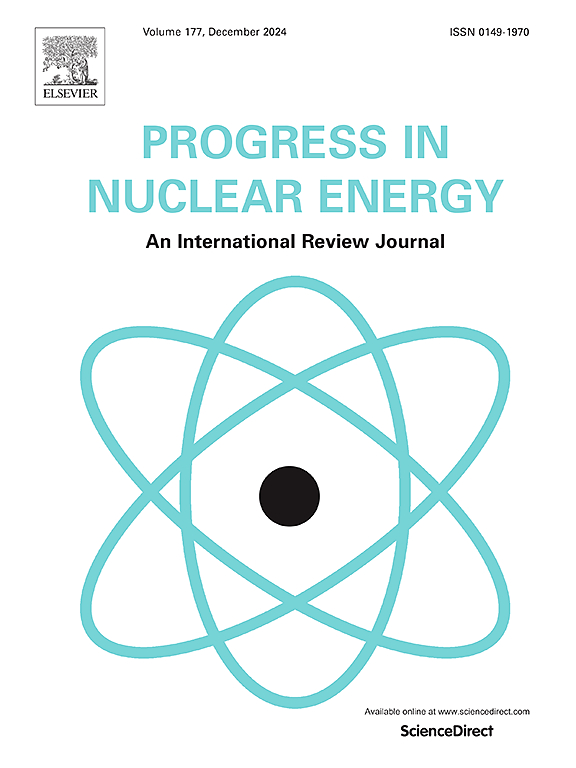AI-driven uncertainty quantification & multi-physics approach to evaluate cladding materials in a microreactor
IF 3.2
3区 工程技术
Q1 NUCLEAR SCIENCE & TECHNOLOGY
引用次数: 0
Abstract
The pursuit of enhanced nuclear safety has spurred the development of accident-tolerant cladding (ATC) materials for light water reactors (LWRs). This study investigates the potential of repurposing these ATCs in advanced reactor designs, aiming to expedite material development and reduce costs. The research employs a multi-physics approach, encompassing neutronics, heat transfer, thermodynamics, and structural mechanics, to evaluate four candidate materials (Haynes 230, Zircaloy-4, FeCrAl, and SiC–SiC) within the context of a high-temperature, sodium-cooled microreactor, exemplified by the Kilopower design. While neutronic simulations revealed negligible power profile variations among the materials, finite element analyses highlighted the superior thermal stability of SiC–SiC and the favorable stress resistance of Haynes 230. The high-temperature environment significantly impacted material performance, particularly for Zircaloy-4 and FeCrAl, while SiC–SiC’s inherent properties limited its ability to withstand stress loads. Additionally, AI-driven uncertainty quantification and sensitivity analysis were conducted to assess the influence of material property variations on maximum hoop stress. The findings underscore the need for further research into high-temperature material properties to facilitate broader applicability of existing materials to advanced reactors. Haynes 230 is identified as the most promising candidate based on the evaluated criteria.
人工智能驱动的不确定性量化&多物理场方法评估微反应堆包层材料
对提高核安全的追求推动了轻水反应堆耐事故包层材料的发展。本研究探讨了在先进反应堆设计中重新利用这些ATCs的潜力,旨在加快材料开发和降低成本。该研究采用了多物理场方法,包括中子学、传热学、热力学和结构力学,在高温钠冷却微反应堆的背景下评估了四种候选材料(Haynes 230、Zircaloy-4、FeCrAl和SiC-SiC),以Kilopower设计为例。虽然中子模拟显示材料之间的功率分布变化可以忽略不计,但有限元分析强调了SiC-SiC优越的热稳定性和Haynes 230良好的抗应力性。高温环境显著影响了材料的性能,尤其是锆合金4和FeCrAl,而SiC-SiC的固有特性限制了其承受应力载荷的能力。此外,还进行了人工智能驱动的不确定性量化和敏感性分析,以评估材料性能变化对最大环向应力的影响。这一发现强调了进一步研究高温材料特性的必要性,以促进现有材料在先进反应堆中的更广泛适用性。根据评估标准,Haynes 230被确定为最有希望的候选者。
本文章由计算机程序翻译,如有差异,请以英文原文为准。
求助全文
约1分钟内获得全文
求助全文
来源期刊

Progress in Nuclear Energy
工程技术-核科学技术
CiteScore
5.30
自引率
14.80%
发文量
331
审稿时长
3.5 months
期刊介绍:
Progress in Nuclear Energy is an international review journal covering all aspects of nuclear science and engineering. In keeping with the maturity of nuclear power, articles on safety, siting and environmental problems are encouraged, as are those associated with economics and fuel management. However, basic physics and engineering will remain an important aspect of the editorial policy. Articles published are either of a review nature or present new material in more depth. They are aimed at researchers and technically-oriented managers working in the nuclear energy field.
Please note the following:
1) PNE seeks high quality research papers which are medium to long in length. Short research papers should be submitted to the journal Annals in Nuclear Energy.
2) PNE reserves the right to reject papers which are based solely on routine application of computer codes used to produce reactor designs or explain existing reactor phenomena. Such papers, although worthy, are best left as laboratory reports whereas Progress in Nuclear Energy seeks papers of originality, which are archival in nature, in the fields of mathematical and experimental nuclear technology, including fission, fusion (blanket physics, radiation damage), safety, materials aspects, economics, etc.
3) Review papers, which may occasionally be invited, are particularly sought by the journal in these fields.
 求助内容:
求助内容: 应助结果提醒方式:
应助结果提醒方式:


